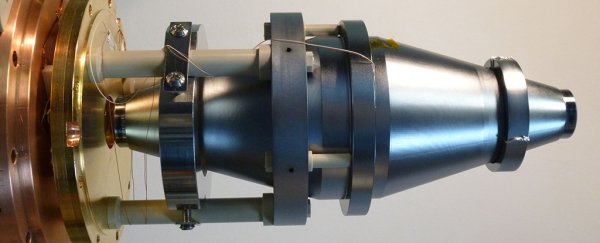Sharper lasers mean better accuracy in all the fields where they're used, and scientists have just set a new record for laser sharpness, building a laser with a linewidth of just 10 millihertz (0.01 hertz).
That linewidth is a measurement of how much of the optical spectrum it covers, and while we haven't achieved the ideal of a laser with just one specific wavelength – photons streamed at a single frequency – we're now closer than ever.
Researchers from the National Metrology Institute of Germany, or PTB (Physikalisch-Technische Bundesanstalt), say one of the ways in which the new laser will prove useful is in keeping our standard of time.
"The smaller the linewidth of the laser, the more accurate the measurement of the atom's frequency in an optical clock," explains one of the researchers, physicist Thomas Legero. "This new laser will enable us to decisively improve the quality of our clocks."
After almost ten years of work, the researchers hit the new record with the help of a Fabry-Pérot silicon resonator, a device used to control light wavelength through two fixed mirrors placed opposite each other and fixed inside a double cone.
The length of the gap between those mirrors, and in particular its stability, controls the linewidth of the laser inside it – so the challenge for scientists was to keep those mirrors as stable as possible.
That meant removing interference from pressure variations, vibrations from sound and seismic waves, and temperature fluctuations.
The final task was to minimise the thermal motion of atoms in the resonator, the Brownian motion that happens in all materials at a finite temperature: to do this, the resonator was made from single-crystal silicon and cooled down to a temperature of -150° Celsius (-238° Fahrenheit).
And then the world's sharpest laser was born. The researchers say the light waves of the laser, oscillating approximately 200 trillion times per second, are stable for 11 seconds or so before they get out of sync.
That's enough time for the light to travel to the Moon and back five times.
If the laser is going to help improve radio communications across deep space though, it's going to have to travel even further, and the PTB team is confident of getting the linewidth down even further, perhaps below 1 millihertz.
In fact, the researchers created two lasers with the same properties – because no one else has created lasers to this specification before, two devices were required to compare against each other and verify key measurements.
For now the lasers are being used to improve the quality of optical atomic clocks and to measure ultracold atoms with greater accuracy.
In the future, the lasers could also be used to measure electromagnetic radiation with more precision and even to test the theory of relativity.
A decade in the making, the new super-sharp laser shows that hard work really does pay off, and we're looking forward to seeing how the technology improves in the future.
The research has been published in Physical Review Letters.
